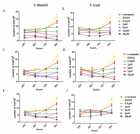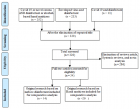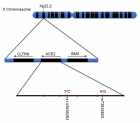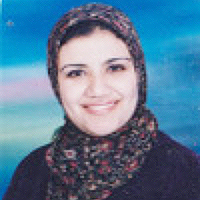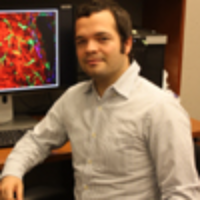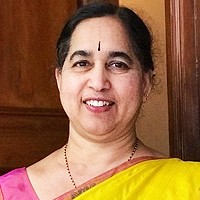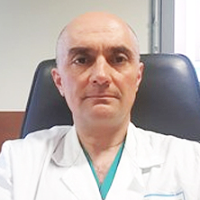Abstract
Case Report
Intracerebral Hemorrhage of Brainstem in triple pregnancy after in vitro fertilization by receiving Ovum Donation: A case report and review
Andreas Suhartoyo Winarno*, Lukas Schloesser, Frederic Dietzel, Percy Balan, Thomas Hoehn, Monika Hampl and Tanja Natascha Fehm
Published: 16 December, 2019 | Volume 2 - Issue 2 | Pages: 138-144
Deliveries prior to 28 weeks’ gestation (extreme preterm birth) pose a global health concern, according to the World Health Organization (WHO). Extreme preterm birth is associated with several complications in the newborn and management in neonatal intensive care unit would incur high expenses. In parallel, advancements in in vitro fertilization will give an opportunity for women to conceive in cases of ovarian failure. At the same time, health providers also encourage patients to receive more than one embryo simultaneously during an embryo transfer. Here we report a case of a patient in coma condition of triplet pregnancy, post ovum donation with three-embryo transfer. Following stabilization, cranial computed tomography (CCT) was performed. The result showed bleeding in the brainstem and into intraventricular spaces at 25+4 gestation weeks. Furthermore, ICH during pregnancy is considered as a rare case in obstetrical field, especially involving the brainstem. This could lead to life-threatening conditions and serious disability in the future. On the fifth day of hospitalization, she suffered from pneumonia and pulmonary edema. On the eight day (26+5 gestations weeks), an emergency caesarean section was performed due to fully dilated of the cervix with breech presentation of all fetuses. Mother and the children survived with some non-life-threatening disabilities.
This is the very first case reported of intracerebral hemorrhage in the brainstem in triplet pregnancy after receiving ovum donation. Heterologous conception could be an iceberg phenomenon of gestational complications among the population. Reproductive tourism could still become greater in the future.
Read Full Article HTML DOI: 10.29328/journal.cjog.1001037 Cite this Article Read Full Article PDF
Keywords:
ICH: Intracerebral Hemorrhage; Triplet; Pregnancy; Prematurity; Ovum donation; IVF: in vitro Fertilization
References
- Gaberel U, Montagne A, Lesept F, Gauberti M, Lemarchand E, et al. Urokinase versus alteplase for intraventricular hemorrhage fibrinolysis. Neuropharmacology. 2014; 85: 158-165. PubMed: https://www.ncbi.nlm.nih.gov/pubmed/24846802
- Steiner T, Salman RAS, Beer R, Christensen H, Cordonnier C, Csiba L, et al. European Stroke Organisation (ESO) guidelines for the management of spontaneous intracerebral hemorrhage. Int J Stroke. 2014; 9: 840-855. PubMed: https://www.ncbi.nlm.nih.gov/pubmed/25156220
- March of Dimes, PMNCH, Save the Children, WHO. Born Too Soon: The Global Action Report on Preterm Birth. Geneva: the World Health Organization; 2012.
- Parry S, Strauss JF. Premature rupture of the fetal membranes. N Engl J Med. 1998; 338: 663-670. PubMed: https://www.ncbi.nlm.nih.gov/pubmed/9486996
- Trounson A, Mohr L. Human pregnancy following cryopreservation, thawing and transfer of an eight-cell embryo. Nature. 1983; 305: 707–709. PubMed: https://www.ncbi.nlm.nih.gov/pubmed/6633637
- Royal college of obstetricians and gynecologists. Fertility: assessment and treatment for people with fertility problems. NICE clinical guideline. 2013; 18: 394-399.
- Shavit T, Hasson J, Ma’mari N, Son WY, Badeghiesh A, et al. Oocyte donation from donor older than 35 years. Is it worth trying? Reprod Sci. 2019; 26: 503-509. PubMed: https://www.ncbi.nlm.nih.gov/pubmed/29806536
- Pecks U, Maass N, Neulen J. Oocyte donation: a risk factor for pregnancy-induced hypertension. A meta-analysis and case series. Dtsch Arztebl Int. 2011; 108: 23-31. PubMed: https://www.ncbi.nlm.nih.gov/pubmed/21285999
- Soma-Pillay P, Nelson-Piercy C, Tolppanen H, Mebazaa A. Physiological changes in pregnancy. Cardiovasc J Afr. 2016; 27: 89-94. PubMed: https://www.ncbi.nlm.nih.gov/pmc/articles/PMC4928162/
- Rao A, Sairam S, Shehata. Obstetric complications of twin pregnancies. Best Pract Res Clin Obstet Gynaecol. 2004; 18: 557-576. PubMed: https://www.ncbi.nlm.nih.gov/pubmed/15279817
- Santana DS, Cecatti JG, Surita FG, Silveira C, Costa ML, et al. Twin pregnancy and severe maternal outcomes. Obstet Gynecol. 2016; 127: 631-641. PubMed: https://www.ncbi.nlm.nih.gov/pubmed/26959199
- Chen J, Wang Y, Li P, Chen W, Zhou J, e al. Treatment of a giant arteriovenous malformation associated with intracranial aneurysm rtupture during pregnancy: a case report. Exp Ther Med. 2016; 12: 1337-1340. PubMed: https://www.ncbi.nlm.nih.gov/pmc/articles/PMC4997910/
- Mehrotra M, Mehrotra A, Nair A, Srivastava A, Sahu RN, et al. Dissecting intracranial aneurysm in pregnancy: a rare association. Asian J Neurosurg. 2012; 12: 127-130. PubMed: https://www.ncbi.nlm.nih.gov/pmc/articles/PMC5379786/
- Heitkamp AC, Dickhoff C, Nederhoed JH, Franschman G, de Vries JI. Saved from a fatal flight: a ruptured splenic artery aneurysm in a pregnant woman. Int J Surg Case Rep. 2015; 8: 32-34. PubMed: https://www.ncbi.nlm.nih.gov/pubmed/25617728
- Wang C, Tu X, Li S, Luo G, Norwitz ER. Spontaneous rupture of the spleen: a rare but serious case of acute abdominal pain in pregnancy. J Emerg Med. 2011; 41: 503-506. PubMed: https://www.ncbi.nlm.nih.gov/pubmed/20813482
- Kenny B, Volobuev V. Splenic rupture following elective caesarean delivery at term, complicated by low-molecular-weight heparin use. Aust N Z J Obstet Gynaecol. 2007; 47: 514-516. PubMed: https://www.ncbi.nlm.nih.gov/pubmed/17991122
- Di Vella G, Arpaio A, Marzullo A, Colonna M. Rupture of the spleen or splenic vessels (splenic emergency syndrome) in late pregnancy: a report of two autopsy cases. Forensic Sci Int. 2008; 176: 1-5. PubMed: https://www.ncbi.nlm.nih.gov/pubmed/17728086
- Turan N, Oghan F, Boran T. Spontaneous rupture of splenic vein in a pregnant woman during a religious ritual. J Forensic Leg Med. 2007; 14: 440-443. PubMed: https://www.ncbi.nlm.nih.gov/pubmed/17720597
- Hamedi B, Shomali Z. Postpartum spontaneous rupture of spleen in a woman with severe preeclampsia: a case report and review of the literature. Bull Emerg Trauma. 2013; 1:46-48. PubMed: https://www.ncbi.nlm.nih.gov/pubmed/27162822
- Kazaryan AM, Wiborg J, Hauss K, Anundsen TK, Flemmen OJ, et al. Spontaneous non-traumatic massive intra-abdominal spleen bleeding in young females: importance of ATLS principles and trauma alarm. Am J Case Rep. 2014; 15: 189-193. PubMed: https://www.ncbi.nlm.nih.gov/pmc/articles/PMC4020906/
- Jick SS, Myers MW, Jick H. Risk of idiopathic cerebral haemorrhage in women on oral contraceptives with differing progestagen components. Lancet 1999; 354: 302-303. PubMed: https://www.ncbi.nlm.nih.gov/pubmed/10440310
- O'Connor CA, Cernak I, Vink R. Effects of progesterone on neurologic and morphologic outcome following diffuse traumatic brain injury in rats. Experimental Neurol. 2007; 205: 145-153.
- Chang CM, Su YF, Chang CZ, Chung CL, Tsai YJ, et al. Progesterone attenuates experimental subarachnoid hemorrhage-induced vasospasm by upregulation of endothelial nitric oxide synthase via akt signalling pathway. Biomed Res Int. 2014; 207616: 1-6. PubMed: https://www.ncbi.nlm.nih.gov/pmc/articles/PMC4052693/
- Lei B, Wang H, Jeong S, Hsieh JT, Majeed M, et al. Progesterone improves neurobehavioral outcome in models of intracerebral hemorrhage. Neuroendocrinology 2016; 103: 665-677. PubMed: https://www.ncbi.nlm.nih.gov/pubmed/26562172
- Hsieh JT, Lei B, Sheng H, Venkatraman T, Lascola CD, et al. Sex-specific effects of progesterone on early outcome of intracerebral hemorrhage. Neuroendocrinology. 2016; 103: 518-530. PubMed: https://www.ncbi.nlm.nih.gov/pubmed/26356626
- De Ziegler D, Pirtea P, Andersen CY, Ayoubi JM. Role of gonadotropin-releasing hormone agonists, human chorionic gonadotropin (hCG), progesterone, and estrogen in luteal phase support after hCG triggering, and when in pregnancy hormonal support can be stopped. Fertil Steril. 2018; 109: 749-755. PubMed: https://www.ncbi.nlm.nih.gov/pubmed/29778367
- Thomsen LH, Kesmodel US, Andersen CY, Humaidan P. Daytime Variation in Serum Progesterone during the Mid-Luteal Phase in Women Undergoing in vitro Fertilization Treatment. Front Endocrinol (Lausanne). 2018; 9: 1-10. PubMed: https://www.ncbi.nlm.nih.gov/pubmed/29615975
- Aguilera M, Ramin K, Nguyen R, Giacobbe L, Swartout J. Emergency cerclage placement in multifetal pregnancies with a dilated cervix and exposed membranes: case series. AJP Rep. 2013; 3: 1-4. PubMed: https://www.ncbi.nlm.nih.gov/pubmed/23943699
- Mathews TJ, MacDorman MF. Infant mortality statistics from the 2006 period linked birth/infant death data set. Natl Vital Stat Rep. 2010; 58: 1-31. PubMed: https://www.ncbi.nlm.nih.gov/pubmed/20815136
- Martin JA, Hamilton BE, Sutton PD, Ventura SJ, Mathews TJ, et al. Births: Final data for 2008. Natl Vital Stat Rep. 2010; 59: 1-72. PubMed: https://www.ncbi.nlm.nih.gov/pubmed/22145497
- American College of Obstetricians and Gynecologists. ACOG practice bulletin no. 142: Cerclage for the management of cervical insufficiency. Obstet Gynecol. 2014; 123: 372-379. PubMed: https://www.ncbi.nlm.nih.gov/pubmed/24451674
- Lee MS, Cantonwine D, Little SE, McElrath TF, Parry SI, et al. Angiogenic markers in pregnancies conceived through in vitro fertilization. Am J Obstet Gynecol. 2015; 212: e1-e8. PubMed: https://www.ncbi.nlm.nih.gov/pubmed/25797229
- Porras JL, Yang W, Philadelphia E, Law J, Garzon-Muvdi T, et al. Hemorrhage risk of brain arteriovenous malformations during pregnancy and puerperium in a north America cohort. Stroke 2017; 48: 1507-1513. PubMed: https://www.ncbi.nlm.nih.gov/pubmed/28487334
- Liu XJ, Wang S, Zhao YL, Teo M, Guo P, et al. Risk of cerebral arteriovenous malformation rupture during pregnancy and puerperium. Neurology. 2014; 82: 1798-1803. PubMed: https://www.ncbi.nlm.nih.gov/pubmed/24759847
- Deutsche- (German), Oesterreichische- (Austria), Schweizerische- (Swiss) Gesellschaft fuer Gynaekologie und Geburtshilfe. Leitlinien S2k für Prävention und Therapie der Fruehgeburt (Guideline for prevention and therapy in preterm birth). Arbeitsgemeinschaft der Wissenschaftlichen Medizinischen Fachgesellschaften (AWMF) 2019; 1 (015-025): 1-227. PubMed: https://www.ncbi.nlm.nih.gov/pmc/articles/PMC6690742/
Figures:
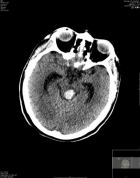
Figure 1
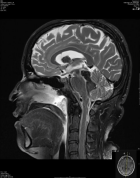
Figure 2
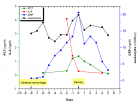
Figure 3
Similar Articles
-
TMD and pregnancy?Afa Bayramova*. TMD and pregnancy?. . 2018 doi: 10.29328/journal.cjog.1001001; 1: 001-006
-
Screening of Gestational diabetes mellitusGehan Farid*,Sarah Rabie Ali*,Reem Mohammed Kamal. Screening of Gestational diabetes mellitus . . 2018 doi: 10.29328/journal.cjog.1001003; 1: 014-023
-
The Case of the Phantom Trophoblastic TumorBenedict B Benigno*. The Case of the Phantom Trophoblastic Tumor. . 2018 doi: 10.29328/journal.cjog.1001004; 1: 024-025
-
Maternal and fetal outcome of comparative study between old & adopted new value of screening of Gestational Diabetes Mellitus in tertiary centre in Saudi ArabiaGehan Farid*,Reem Mohammed Kamal*,Mohamed AH Swaraldahab,Sarah Rabie Ali. Maternal and fetal outcome of comparative study between old & adopted new value of screening of Gestational Diabetes Mellitus in tertiary centre in Saudi Arabia. . 2018 doi: 10.29328/journal.cjog.1001005; 1: 026-034
-
Septic arthritis of left shoulder in pregnancy following minor hand injuryNeelam Agrawal,Rhoughton Clemmey,Shamma Al-Inizi*. Septic arthritis of left shoulder in pregnancy following minor hand injury. . 2018 doi: 10.29328/journal.cjog.1001010; 1: 058-060
-
Value of ambulatory blood pressure measure in pregnancy hypertensionAna Correia*,Fátima Leitão. Value of ambulatory blood pressure measure in pregnancy hypertension. . 2018 doi: 10.29328/journal.cjog.1001012; 1: 067-072
-
Managing epileptic women in pregnancySarmad Muhammad Soomar*,Saima Rajpali. Managing epileptic women in pregnancy. . 2019 doi: 10.29328/journal.cjog.1001015; 2: 001-002
-
Hypertriglyceridemia induced acute pancreatitis in pregnancy: Learning experiences and challenges of a Case reportSufia Athar*,Joohi Ramawat,Mohammad Abdel Aziz,Vincent Boama. Hypertriglyceridemia induced acute pancreatitis in pregnancy: Learning experiences and challenges of a Case report. . 2019 doi: 10.29328/journal.cjog.1001017; 2: 006-012
-
Trans-abdominal cervical cerclage revisitedJohn Svigos*. Trans-abdominal cervical cerclage revisited. . 2019 doi: 10.29328/journal.cjog.1001019; 2: 017-024
-
Determinants of women’s perceived satisfaction on Antenatal care in urban Ghana: A cross-sectional studyAkowuah Jones Asafo*,Danquah Benedicta Adoma. Determinants of women’s perceived satisfaction on Antenatal care in urban Ghana: A cross-sectional study. . 2019 doi: 10.29328/journal.cjog.1001022; 2: 038-053
Recently Viewed
-
Cystoid Macular Oedema Secondary to Bimatoprost in a Patient with Primary Open Angle GlaucomaKonstantinos Kyratzoglou*,Katie Morton. Cystoid Macular Oedema Secondary to Bimatoprost in a Patient with Primary Open Angle Glaucoma. Int J Clin Exp Ophthalmol. 2025: doi: 10.29328/journal.ijceo.1001059; 9: 001-003
-
Metastatic Brain Melanoma: A Rare Case with Review of LiteratureNeha Singh,Gaurav Raj,Akshay Kumar,Deepak Kumar Singh,Shivansh Dixit,Kaustubh Gupta*. Metastatic Brain Melanoma: A Rare Case with Review of Literature. J Radiol Oncol. 2025: doi: ; 9: 050-053
-
Depression as a civilization-deformed adaptation and defence mechanismBohdan Wasilewski*,Olha Yourtsenyuk,Eugene Egan. Depression as a civilization-deformed adaptation and defence mechanism. Insights Depress Anxiety. 2020: doi: 10.29328/journal.ida.1001013; 4: 008-011
-
Drinking-water Quality Assessment in Selective Schools from the Mount LebanonWalaa Diab, Mona Farhat, Marwa Rammal, Chaden Moussa Haidar*, Ali Yaacoub, Alaa Hamzeh. Drinking-water Quality Assessment in Selective Schools from the Mount Lebanon. Ann Civil Environ Eng. 2024: doi: 10.29328/journal.acee.1001061; 8: 018-024
-
Rapid Microbial Growth in Reusable Drinking Water BottlesQishan Liu*,Hongjun Liu. Rapid Microbial Growth in Reusable Drinking Water Bottles. Ann Civil Environ Eng. 2017: doi: 10.29328/journal.acee.1001007; 1: 055-062
Most Viewed
-
Evaluation of Biostimulants Based on Recovered Protein Hydrolysates from Animal By-products as Plant Growth EnhancersH Pérez-Aguilar*, M Lacruz-Asaro, F Arán-Ais. Evaluation of Biostimulants Based on Recovered Protein Hydrolysates from Animal By-products as Plant Growth Enhancers. J Plant Sci Phytopathol. 2023 doi: 10.29328/journal.jpsp.1001104; 7: 042-047
-
Sinonasal Myxoma Extending into the Orbit in a 4-Year Old: A Case PresentationJulian A Purrinos*, Ramzi Younis. Sinonasal Myxoma Extending into the Orbit in a 4-Year Old: A Case Presentation. Arch Case Rep. 2024 doi: 10.29328/journal.acr.1001099; 8: 075-077
-
Feasibility study of magnetic sensing for detecting single-neuron action potentialsDenis Tonini,Kai Wu,Renata Saha,Jian-Ping Wang*. Feasibility study of magnetic sensing for detecting single-neuron action potentials. Ann Biomed Sci Eng. 2022 doi: 10.29328/journal.abse.1001018; 6: 019-029
-
Pediatric Dysgerminoma: Unveiling a Rare Ovarian TumorFaten Limaiem*, Khalil Saffar, Ahmed Halouani. Pediatric Dysgerminoma: Unveiling a Rare Ovarian Tumor. Arch Case Rep. 2024 doi: 10.29328/journal.acr.1001087; 8: 010-013
-
Physical activity can change the physiological and psychological circumstances during COVID-19 pandemic: A narrative reviewKhashayar Maroufi*. Physical activity can change the physiological and psychological circumstances during COVID-19 pandemic: A narrative review. J Sports Med Ther. 2021 doi: 10.29328/journal.jsmt.1001051; 6: 001-007

HSPI: We're glad you're here. Please click "create a new Query" if you are a new visitor to our website and need further information from us.
If you are already a member of our network and need to keep track of any developments regarding a question you have already submitted, click "take me to my Query."






